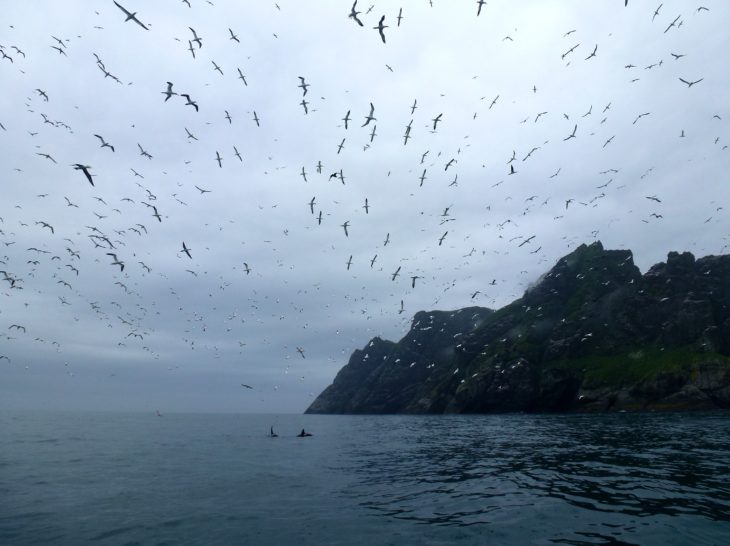Could old oil and gas rigs in the North Sea help marine life?
The transition to a low-carbon economy is gaining pace nationally and internationally. One consequence of this transition will be the big challenge of decommissioning old, redundant energy infrastructure in the North Sea.
The North Sea oil and gas sector has been a cornerstone of UK industry for over 50 years. At its peak in 1999, the industry was producing over six million barrels of oil a day. While oil production has steadily decreased to 1.5 million barrels a day, the extensive array of infrastructure needed to support this industry is largely still in place. At present, there are around 470 oil rigs, 10,000 km of pipeline, and 5,000 oil wells in the North Sea.
In many of the older wells, extracting any remaining oil has already become economically marginal or unviable and such wells now need to be taken out of service. Once the well has been plugged, the surrounding rig, steel pipelines and all other subsea infrastructure then needs to be dealt with.

Under current OSPAR Convention regulations, oil companies are responsible for removing all the structures they place on the seafloor, and are required to submit a plan for dismantling, reusing, recycling, and disposing of all structural and waste materials at the well site. This process is known as decommissioning.
Decommissioning is a highly complex and challenging procedure. It has been estimated that decommissioning all the UK’s North Sea operations could take 30-40 years and cost the industry and the UK Government tens of billions of pounds. Cost estimates vary widely from £35 billion to around 70 billion.
For many oil rigs, complete removal can be the most straightforward operation. Here, the rig frame is cut just below the seafloor and lifted to the surface as a single piece. However, during the industry’s rapid expansion in the 1970s, many rigs were installed quickly with little thought given to how they would be removed in the future.
This lack of foresight resulted in the construction of some extremely large structures whose removal is considered dangerous and perhaps not even possible in some cases, particularly for structures located in deep water or those built from concrete weighing in the region of 300,000 tonnes, known as gravity-based structures.
In the late 1990s, concerns associated with removing such structures were widely recognised amongst the industry, academics and government and resulted in the adoption of the OSPAR 98/3 regulation. This regulation allows for oil companies to apply for derogation (exemption) to leave some rigs and structures in place.
For derogation to even be a consideration, the structure of the oil rig must fall within a specific set of requirements. These include: pre-1999 construction; steel constructions weighing more than 10,000 tonnes; and/or gravity-based structures. In the North Sea, around 40 rigs meet the OSPAR 98/3 requirements for derogation.
if we take an evidence-based, pragmatic approach it could also be a colossal opportunity to turn around many decades of environmental degradation in our seas and along our coasts.
The Scottish Wildlife Trust believes that until the scientific evidence-base is sufficiently developed to provide a full understanding of the role of offshore infrastructure in the marine ecosystem, the starting position should be the existing presumption for complete removal for re-use, recycling or disposal to land.
However, the Trust is prepared to support pragmatic solutions to decommissioning, based on the likely net environmental impact of different options. We believe that these options should be assessed through natural capital-based analysis, in other words taking into account all of the costs and benefits – including those that might normally remain hidden – on the basis that damage to the environment comes at a cost to society.
The Trust accepts that our pragmatic stance may require a broadening out of the derogation criteria under regulation OSPAR 98/3. If this was to happen then some rigs might be retained as artificial reefs. Examples of such ‘rigs to reefs’ projects have been successful in other parts of the world with the resulting ‘wrecks’ known to support a diverse range of marine life.

Clearly there would be substantial financial savings from extending derogations beyond the 40 or so structures in the North Sea that currently qualify. We propose a percentage of the savings from any derogations are placed in a national Marine Stewardship Fund that supports marine conservation and research.
This could create a triple-win: savings to the operator and taxpayer; enhanced (if modified) marine life around old structures; and a significant fund available for better stewardship of the marine environment. At a time when resources for marine conservation and research face an uncertain future, such a national fund could be very timely.
Over the next 50 years, the decommissioning of oil and gas structures in the North Sea will be a colossal job. And yet, if we take an evidence-based, pragmatic approach it could also be a colossal opportunity to turn around many decades of environmental degradation in our seas and along our coasts.
The Scottish Wildlife Trust is ready to work with industry, government and other partners to shape a positive future for the post oil and gas era in the North Sea.
Find out more about the Trust’s Living Seas work and our position on North Sea decommissioning.
 Jonny Hughes is the Chief Executive of the Scottish Wildlife Trust. Follow him on Twitter @jonnyecology
Jonny Hughes is the Chief Executive of the Scottish Wildlife Trust. Follow him on Twitter @jonnyecology
Help protect Scotland’s wildlife
Our work to save Scotland’s wildlife is made possible thanks to the generosity of our members and supporters.
Join today from just £4 a month to help protect the species you love.
Preface
The transition to a low-carbon economy is gaining pace nationally and internationally. One consequence of this transition will be the big challenge of decommissioning old, redundant energy infrastructure in the …
